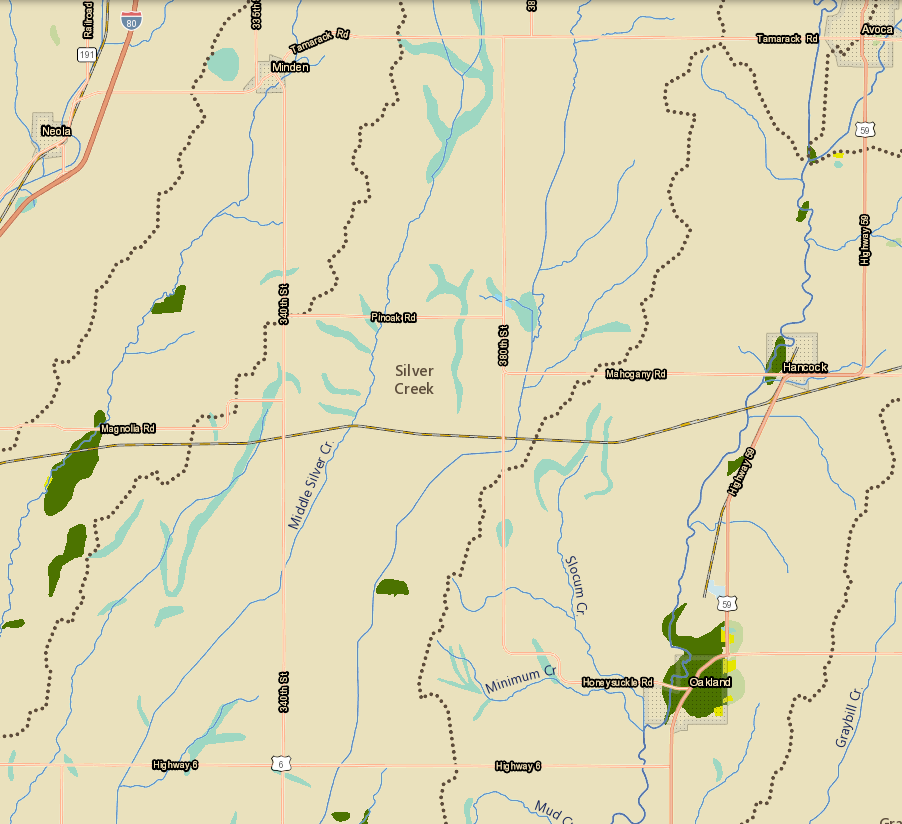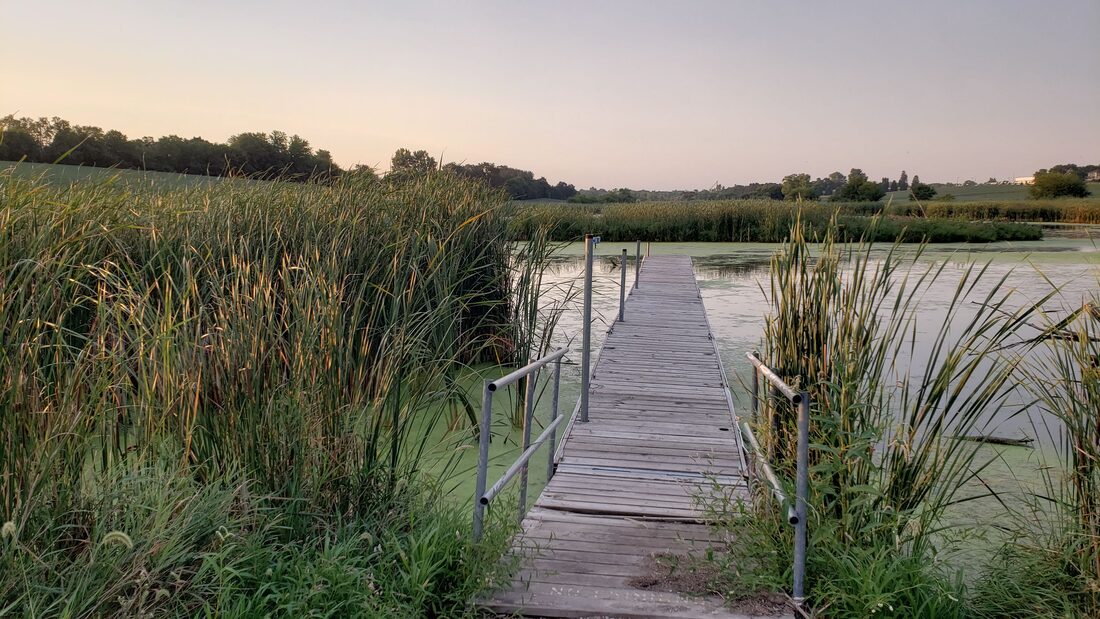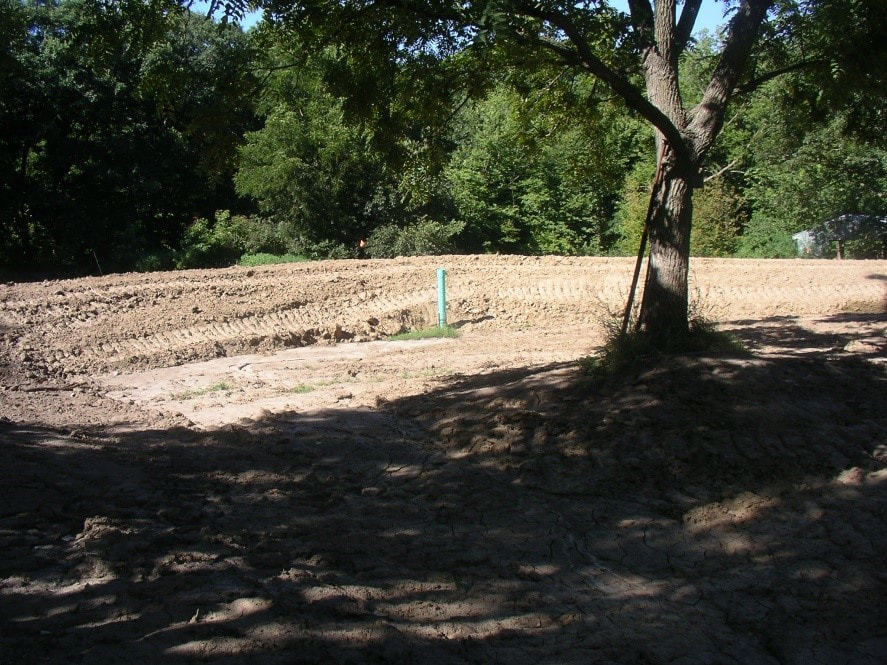|
While many people overlook soil as 'just dirt,' human life depends on healthy soils. Civilizations, in fact, came to fruition in tandem with cultivating soils for agricultural development. Soil degradation and erosion have also contributed to most civilizational collapses throughout world history. Healthy soils provide many benefits, including: •Regulating water, which can help reduce flooding and drought impacts and improve water quality •Sustaining plant and animal life needed to sustain our own lives and livelihoods •Cycling nutrients including carbon, nitrogen, and phosphorous (Source: NRCS). Across much of Iowa and the tallgrass prairie biome, we have lost half or more of our topsoil. Fortunately in recent decades, agricultural conservation practices have significantly reduced the rate of soil erosion, but soil health continues to suffer in many places. In hilly areas like western and southern Iowa, soil quality has decreased in recent years on the tops and sides of hills as topsoil has washed downhill with snowmelt and rainfall. Wind erosion also blows away topsoil, According to the 2021 article by Thaler, Larsen, and Yu, "The extent of soil loss across the US Corn Belt, "[D]egradation of soil quality by erosion reduces crop yields, which can result in food insecurity, conflict (3), and the decline of civilizations (4). Degradation of soils leads not only to economic losses for farmers but also a loss in ecosystem services (5), which alters the ability of soils to regulate hydrologic and biogeochemical cycles. Widespread use of synthetic fertilizers to enhance the function of degraded soils increases food production costs (6) and impairs water resources (7), which negatively impacts human health (8) and aquatic ecosystems (9)." Although it takes time, soil can be regenerated through a few fairly simple practices known as the soil health principles: •Maximizing Presence of Living Roots, •Minimizing Disturbance, •Maximizing Soil Cover, and •Maximizing Biodiversity  Image source: https://www.nrcs.usda.gov/conservation-basics/natural-resource-concerns/soils/soil-health Image source: https://www.nrcs.usda.gov/conservation-basics/natural-resource-concerns/soils/soil-health N0-till, cover crops, extended rotations, and incorporating livestock into the landscape are some of the of practices farmers can use to regenerate soils.
In the coming weeks and months, we'll be going into detail on these principles, and explore how a variety of conservation practices can be used to improve soil health. Golden Hills currently has a few projects working on regenerative practices, including RCPP, ALUS, and Underserved Farmer. If you are a farmer interested in these, feel free to contact us! Stay tuned here for additional information about soil health coming soon!
0 Comments
Regenerative agriculture is a buzzword you might have heard lately. But what does it mean? Check out this video from Regenerative Farmers of America to learn more: Regenerative agriculture aims to improve sustainability for land, water, wildlife, people, and rural communities & economies. While there are certainly challenges to implementing regenerative practices within current systems on a global scale, many farmers across America and beyond have begun to see the benefits of these practices. In a nutshell, regenerative practices include:
Additionally, the principle of knowing your farm's context is often included, as each piece of land is different based on things like soils, topography, and climate. Practices that work well on one farm wont' always be best on another farm. Golden Hills will be working with local farmers in the coming years to incorporate practices that build soil health and provide environmental benefits, as well as more nutritious food and help rural communities.
Stay tuned and learn more at goldenhillsrcd.org/regenag (from Iowa Learning Farms)
Iowa Learning Farms, in partnership with the Iowa Nutrient Research Center, and Conservation Learning Group (CLG), is hosting a free virtual field day highlight the stream stabilization efforts in the East and West Nishnabotna Watersheds to improve water quality and reduce flooding on Thursday, March 18 at 1 p.m. CST. Join us for a live discussion with Cara Marker-Morgan, project coordinator for the East and West Nishnabotna River Watersheds and Golden Hills RC&D, and Jake Miriovsky, Project Manager For JEO Consulting Group, Inc. Located in the Loess Hills region of Iowa, the East and West Nishnabotna Watersheds were selected to work with the Iowa Flood Center at the University of Iowa and many other partners to develop Watershed Management Authorities as part of the Iowa Watershed Approach. Through the project, Iowans are working together to address factors that contribute to floods and nutrient flows and enjoy the improvements in quality of life and health resulting from upstream watershed investments. Supported by U.S. Housing & Urban Development dollars, this approach is leveraging the principles of Iowa’s innovative Nutrient Reduction Strategy to make communities more resilient to flooding and help improve water quality. “One of the keys to success on projects within a watershed is collaboration. This project is a perfect example of that with multiple landowners coming together to make a difference in our watershed,” noted Marker-Morgan. To participate in the live virtual field day at 1:00 pm CST on March 18 to learn more, click this URL: https://iastate.zoom.us/meeting/register/tJUpduihpj8iE9ZHcjpsenc2DWQILG41wg0D or visit www.iowalearningfarms.org/page/events and click “Join Live Virtual Field Day”. Or, join from a dial-in phone line: Dial: +1 312 626 6799 or +1 646 876 9923 Meeting ID: 914 1198 4892 The field day will be recorded and archived on the ILF website so that it can be watched at any time. The archive will be available at https://www.iowalearningfarms.org/page/events. Participants may be eligible for a Certified Crop Adviser board-approved continuing education unit (CEU). Information about how to apply to receive the credit (if approved) will be provided at the end of the live field day. Established in 2004, Iowa Learning Farms is building a Culture of Conservation by encouraging adoption of conservation practices. Farmers, researchers and ILF team members are working together to identify and implement the best management practices that improve water quality and soil health while remaining profitable. Partners of Iowa Learning Farms include the Iowa Department of Agriculture and Land Stewardship, Iowa State University Extension and Outreach, Leopold Center for Sustainable Agriculture, USDA Natural Resources Conservation Service, and Iowa Department of Natural Resources (USEPA section 319) and GROWMARK, Inc. February 2 is World Wetlands Day, an annual event to "raise global awareness about the vital role of wetlands for people and our planet. This day also marks the date of the adoption of the Convention on Wetlands on 2 February 1971." The month of May has been designated as National Wetlands Month, "created in 1991 by EPA and its federal, state, tribal, local, non-profit, and private sector partners to celebrate the vital importance of wetlands to the nation's ecological, economic, and social health and to educate Americans about the value of wetlands as a natural resource." What is a wetland? According to U.S. Fish & Wildlife Service, "Wetlands are lands transitional between terrestrial and aquatic systems where the water table is usually at or near the surface or the land is covered by shallow water. For the purposes of this classification wetlands must have one or more of the following three attributes: (1) at least periodically, the land supports predominantly hydrophytes; (2) the substrate is predominantly undrained hydric soil; and (3) the substrate is nonsoil and is saturated with water or covered by shallow water at some time during the growing season of each year." (Source: USGS National Water on Wetland Water Resources). Why they matter: A few wetland facts from Iowa Association of Naturalists' Iowa's Biological Communities series on Iowa Wetlands:
Most of Iowa's wetlands were located in the Des Moines Lobe, known as the Prairie Pothole region due to the abundance of small lakes, ponds, and wetlands from the most recent glaciation. But even western Iowa had plenty of wetlands. The early General Land Office surveys from the mid-19th Century shows wet areas in the rolling hills of northern Shelby and Pottawattamie counties, for example. While these areas are generally well-drained, beaver dams on small streams likely helped create many of the wetlands. The Missouri Alluvian Plain and valleys of other large rivers also had wetlands, as they flooded regularly prior to channelization and damming. Wetlands offer many benefits to people, wildlife, land, and water. They are sometimes called "nature's kidneys" due to their ability to cleanse water before it enters streams and rivers. They absorb excess nutrients and chemicals from agriculture and industry, as well as trap sediment from soil erosion. They capture excess water and slowly soak it into the ground, which reduces flooding. Wetlands can also provide recreational opportunities like hunting, trapping, fishing, wildlife watching, birding, and paddling. Living or even spending time near biodiversity, greenery, and water have all been shown to improve well-being and happiness. Areas that are often too wet for farming can be problematic for farmers, but several funding programs are available to restore wetlands and make it profitable, including the Wetland Reserve Program, Conservation Reserve Program, Conservation Reserve Enhancement Program, and Farmable Wetlands Program (Source: NRCS Restoring Iowa Wetlands). Watch this Introduction to Iowa's Wetlands video from Iowa State University for some background: This video from Iowa Outdoors provides a great summary of wetland restoration in Iowa. And this video from The Nature Conservancy is an excellent primer on the benefits of Iowa's wetlands. Learn more about World Wetlands Day and how you can help protect and restore these fragile and endangered ecosystems at worldwetlandsday.org
More Links & Resources Although it's often easy to not think about it, water is one of the most important parts of our everyday lives. From recreation to cleaning to drinking to growing and cooking food, water is all around us all the time. Our quality of life can suffer when we have too much (flooding), not enough (drought), or low-quality water (in our surface waters or our wells).
Golden Hills is introducing Nishy the Loch Nish Monster to help people get to know the Nishnabotna Watershed, and educate about how our local water bodies and sourcewater can be impacted by water quantity and quality issues. Nishy the five-foot floaty will visit sites throughout the watershed and share information about challenges and solutions for improving water quality, reducing flooding impacts, and improving river recreation in the region. Golden Hills coordinates the East and West Nishnabotna Watershed Managment Coalition which aims to reduce flooding and improve water quality throughout the watershed. Follow the watershed coalition on Facebook. We have also been involved with the West Nishnabotna Water Trail in Pottawattamie County since it began in 2010. We are currently partnering with Shelby County Conservation and Iowa DNR to determine feasibility of extending the water trail designation north into Shelby County. Follow the water trail on Facebook. Learn more about all of Golden Hills' land and water conservation projects at http://www.goldenhillsrcd.org/conservation.html and follow Golden Hills on Facebook and Instagram. Stay tuned for Nishy updates! Golden Hills is working with Iowa Rivers Revival and local partners to host the Master River Stewards Program (MRSP) in western Iowa in 2019. MRSP is an adult-education program that teaches watershed awareness, paddling and navigating skills, river and stream dynamics, aquatic habitat, water quality and water monitoring, and policies related to floodplains, river protection and restoration.
Cost for the program is $50 but financial assistance may be available upon request. Registration will close on August 12 or when maximum capacity is reached. This is a certificate program and participants are expected to attend all sessions to receive certification. If you are unable to attend all sessions but are still interested in participating, we may be able to accommodate. Email Project Coordinator Lance Brisbois with questions: [email protected]. For a more detailed agenda and registration, visit Golden Hills' MRSP web page. Golden Hills staff will be at four county fairgrounds in July with information about our recent water quality projects installed at the fairgrounds. Staff will have free information to hand out and will have activities for youth to learn about watersheds and water quality. Tentative dates and times are below:
Fremont County Fairgrounds
Additionally, join us on Tuesday, July 16 for a tour of three of the sites with IDALS Secretary Mike Naig! Golden Hills RC&D invites the public to a ribbon-cutting ceremonies for the completion of three bioretention cells at the Mills, Montgomery, and Fremont county fairgrounds. These water quality practices will help slow the flow of rainwater on its path to enter the Nishnabotna River, preventing flooding, soil erosion, and nutrient runoff. These projects are funded by the Iowa Department of Agriculture and Land Stewardship’s Water Quality Initiative Grant.
Golden Hills RC&D has partnered with the Iowa Department of Agriculture and Land Stewardship to welcome Iowa Secretary of Agriculture Mike Naig to our region and celebrate completion of these projects in an effort to raise awareness of urban water quality practices in rural communities. The ribbon cutting ceremonies will take place Tuesday, July 16th at each of the fairgrounds. The times are listed below. Mills County (Malvern)- 3:00 PM Fremont County (Sidney) - 5:00 PM Montgomery County (Red Oak) - 7:00 PM Learn more about this project here. Iowa Department of Agriculture and Land Stewardship recently announced
funding for the 2019 round of Iowa Water Quality Initiative (WQI) program. Golden Hills was awarded funding for our project, "Bringing Urban Practices to Rural Communities." This is a multi-site project that will add urban water quality practices (bioretention cells and rain gardens) to county courthouses and fairgrounds in Avoca, Glenwood, Malvern, Oakland, Red Oak, and Sidney. We will also add a rain garden at our office in Oakland. Each site will include education and outreach for youth and adults. See the bottom of this page for scheduled events. Projects will be constructed in spring-summer 2019 and spring 2020. This effort includes public education and outreach. Prior to each project build, we will host an educational session targeted towards youth (but open to all ages). 4-H and FFA members are especially encouraged to attend, but you do not need to be a member of either to join. These sessions will discuss issues related to water quality and quantity and tie back to our local Nishnabotna watershed. This information will help people understand why practices like rain gardens and bioretention cells are important. Each project site will be visible to the public beyond county fair time and able to be used for additional education and outreach about both water quality practices such as rain gardens, bioswales permeable pavers, and native vegetation. Each site will have a kickoff event as well as a public ribbon cutting when completed. Project partners will have an informational booth at the sites during county fairs to educate fairgoers about the water quality practices. We will rely on volunteers to help build each project. We are seeking donations for mulch, sand, rock, plants and equipment. At each of the fairgrounds, we will host a ribbon-cutting event once the project is complete. Learn more about the project and how you can get involved on the project web page. By John Thomas, Project Director and Fluvial Geomorphologist for the Hungry Canyons Alliance. This article is part of the Loess Country series--check back for more soon!
Erosion control or stabilization of deep gullies in the Loess Hills is challenging since filling the gully and excavating a core trench in an area of such deep ravines is often cost-prohibitive. The only practical way to stop gully erosion is with a pipe-drop structure that passes water runoff from the top to the base of the gully through a pipe. The Hungry Canyons Alliance (HCA), in conjunction with the USDA-Natural Resource Conservation Service, is using directional drilling techniques to bore a hole at an angle through the loess soil from upstream of the headcut to the base of the gully wall. Polyethylene (PE) pipe is inserted at the base and pulled back up through the bore hole from downstream to upstream. The slurry used to drill the hole acts as a sealant between the pipe and soil making the borehole watertight as it dries. A vertical perforated PE riser is added to the angled drainage pipe to serve as an inlet. A water-retention basin is excavated upstream of the inlet, and a dam or terrace is built downstream between the inlet and the headcut of the ravine to collect water for gradual drainage through the riser and pipe. The basin allows a larger storm event to be controlled by the small drainage pipe. No filling or other work is done in the gully, dramatically reducing earthwork costs. The near-vertical gully slopes will gradually slump to a stable slope over time because collapsed debris will not be carried away by surges of runoff. Twelve of these experimental Bored Headcut Basin (BHB) structures have been built in the Loess Hills since 2007 to control 20 – 80-ft deep gully headcuts with small drainage areas (0.5 – 37 acres). These BHB’s have averaged only about $11,000 to build, with a maximum of around $17,000. They have weathered up to 4-inch rain events without incident. Considering that a traditional pipe-drop structure may cost as much as $60,000, the BHB has proven very cost-effective. HCA continues to monitor the progress of these structures while planning future BHB projects. If you are interested in controlling gully erosion on your property, please call your local USDA-NRCS office. Cost share for these projects have averaged 78%, so the average landowner cost for these projects has been only about $2,400. Plus, the USDA-NRCS provides survey and design assistance. |
Archives
June 2024
Categories
All
|
Address712 South Highway Street
P.O. Box 189 Oakland, IA 51560 |
ContactPhone: 712-482-3029
General inquiries: [email protected] Visit our Staff Page for email addresses and office hours. |























 RSS Feed
RSS Feed